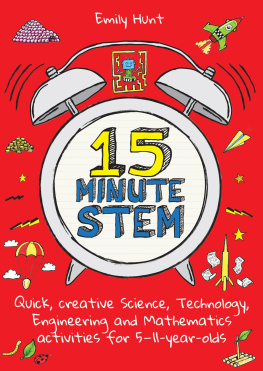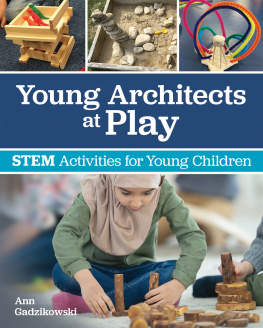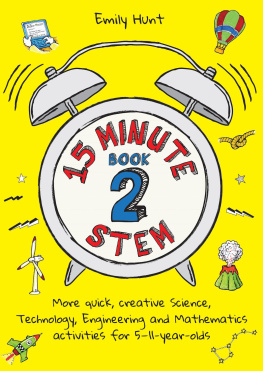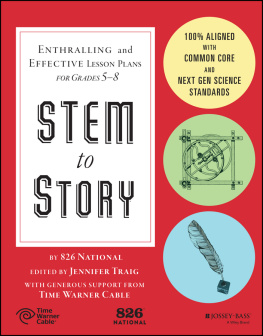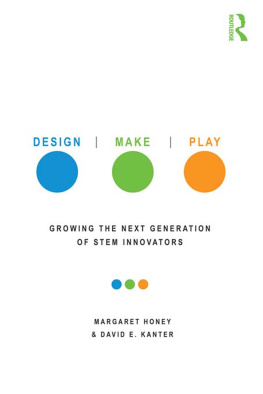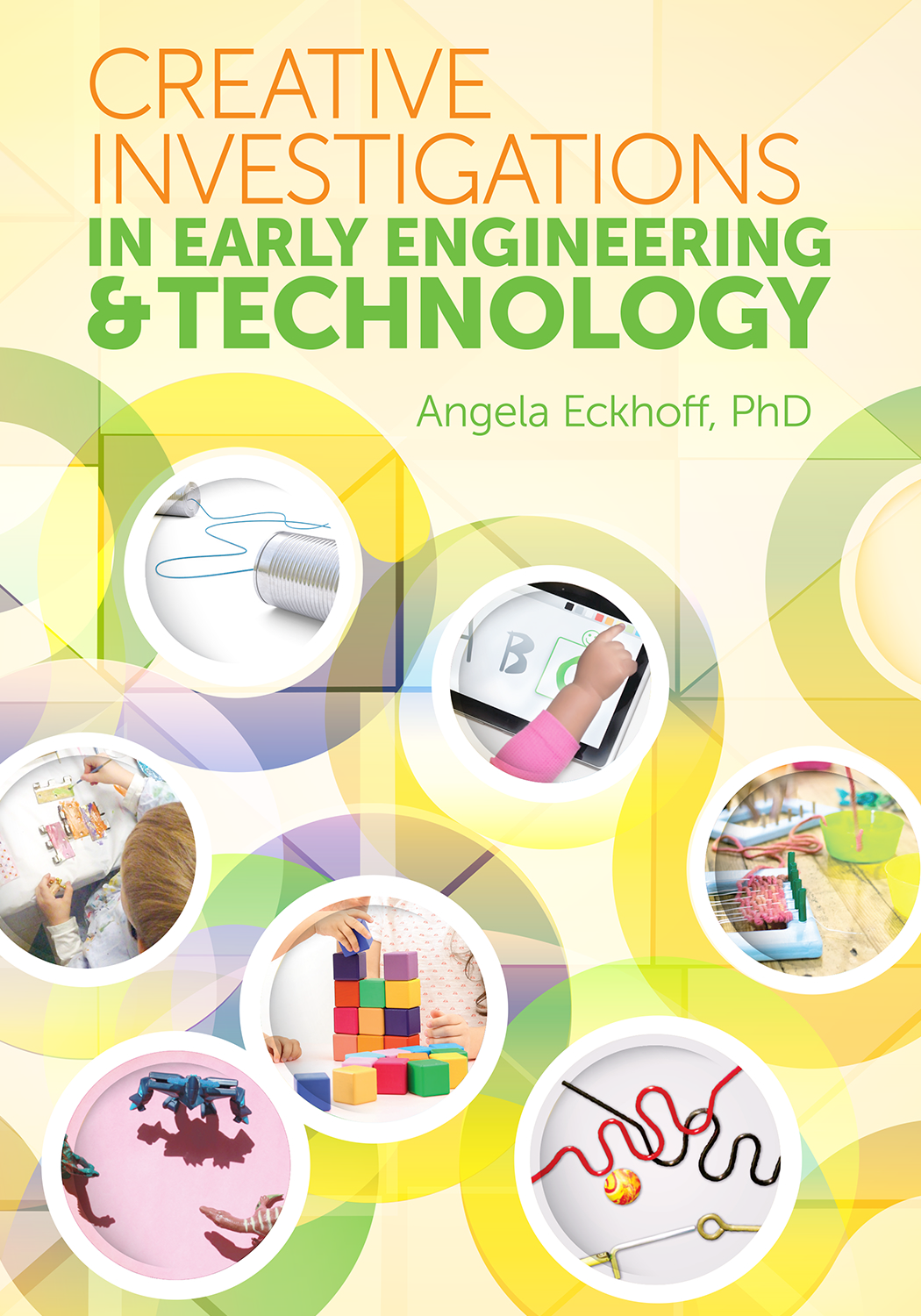Contents
1:
2:
3:
4:
5:


Copyright 2018 Angela Eckhoff
Published by Gryphon House, Inc.
P. O. Box 10, Lewisville, NC 27023
800.638.0928; fax 877.638.7576
www.gryphonhouse.com
All rights reserved. No part of this publication may be reproduced or transmitted in any form or by any means, electronic or technical, including photocopy, recording, or any information storage or retrieval system, without prior written permission of the publisher. Printed in the United States. Every effort has been made to locate copyright and permission information.
Cover images used under license from Shutterstock.com and courtesy of the author. Interior images courtesy of the author.
Bulk Purchase
Gryphon House books are available for special premiums and sales promotions as well as for fund-raising use. Special editions or book excerpts also can be created to specifications. For details, call 800.638.0928.
Disclaimer
Gryphon House, Inc., cannot be held responsible for damage, mishap, or injury incurred during the use of or because of activities in this book. Appropriate and reasonable caution and adult supervision of children involved in activities and corresponding to the age and capability of each child involved are recommended at all times. Do not leave children unattended at any time. Observe safety and caution at all times.
Library of Congress Cataloging-in-Publication Data
The Cataloging-in-Publication Data is registered with the Library of Congress for ISBN 978-0-87659-755-2.
Dedication
To my favorite makers and tinkerers, Griffin and Cullen. Thank you for the inspiration!
Introduction
The excitement level is high in Mr. Adamss classroom because the children are anxious to modifyby painting, cutting, and gluingthe found objects they have been collecting during the week. Mr. Adams and his students are working on a long-term project on recycling and reuse. For this part of the project, the children are using discarded objects to create three-dimensional (3-D) sculptures. They have been studying artists who create assemblage art out of natural and man-made materialsassemblage is art that is made by putting together dissimilar elements, often everyday objects, found and reinvented by the artist. As a design-based learning project, the assemblage project is an iterative process where the children are actively involved in every step: investigating the context through studying the need for recycling and reuse; learning about the ways in which people, including assemblage artists, reuse discarded objects; deciding what objects can be reused in art; collecting and sharing their found objects; thinking through and drafting designs for their artworks; modifying and assembling objects to create their artworks and reworking any aspect of their designs once they have assembled their artwork.
This marks the beginning of the point in the project where the children must transfer their 2-D drawings of their imagined artwork into a 3-D work using the objects they have collected and modified. The design-based nature of this project encourages the children to try out their ideas and revise or change them as necessary when they run into unexpected challenges. As a first step, Finn has decided to use brass door hinges to create a robot family. In his drawing, he has the door hinges making up the torso of the robots. The robots are each different colors, so Finn decides that he must paint the hinges before assembling the robot. Finn carefully chooses colors that match the colors he drew on his robot sketch. As he paints, Mr. Adams checks in and asks Finn how the painting process is going. Finn shares that he is frustrated that the paint isnt drying quickly, so he wont be able to glue his pieces together today. Mr. Adams pauses to remind Finn that the assemblage artworks dont have to be finished quickly and that he should take the time he needs to paint and put together his robot. All week? asks Finn, and Mr. Adams replies, You can work on it all week and even into next week. Remember the artwork we looked at on the iPad? Those artists worked for months and even years designing and making those sculptures. You have to remember that your robot isnt going to lay flat, so you can see it from all sides. Finn stops painting and picks up one of his hinges; flipping it over, he says, Im going to paint the back too. Its the back of his robot shirt. Right, says Mr. Adams. Now youve got it; think it through!
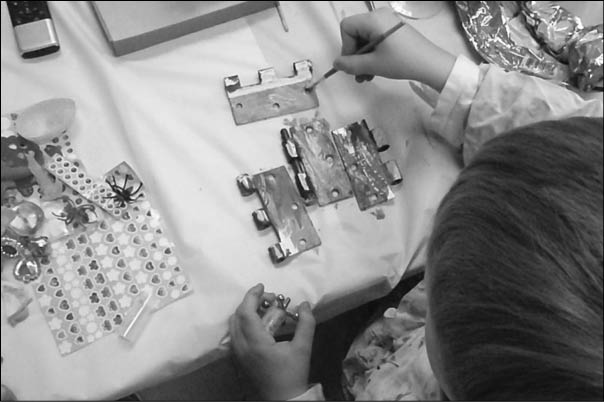
Finn reinvents the door hinges into colorful robot bodies.
As Mr. Adams shared with Finn, design-based learning is typically project based and encourages the students to work on a project over an extended period of time. Project-based work takes time. Ample time is needed so that students are provided the space to think deeply about a topic, problem, or area of interest. Often, in preschool classrooms, we dont provide children with enough opportunities to engage with their thinking at a deep level, but that can be changed when we integrate design-based thinking and project work into our daily routines. Design-based work connects well with content areas of engineering and technology as children engage in cycles of exploration, problem solving, and solution finding.
This book is designed to provide you with knowledge and lesson ideas that scaffold young childrens experiences with engineering and technology while also building inquiry and creative thinking skills. You will find information on contemporary creativity and design-based pedagogical practices that early childhood educators can use to implement engineering and technology learning experiences for preschoolers. This book will broaden understandings of the relationship between engineering and technology content, the role of the learning environment, and supportive pedagogical practices for preschool-aged children. Many early childhood teachers are uncertain about whether engineering and technology experiences are developmentally appropriate for preschoolers and when and how they should introduce these topics to their students. When engineering and technology experiences build upon student interests and connect to other areas of content learningliteracy, science, the arts, mathematics, and social studiesyoung children are able to experience meaningful connections among each content area.
This book stresses the importance of encouraging minds-on learning experiences in the early childhood classroom through guided and independent investigations where every child is actively involved in meaningful ways. Early childhood educators have important roles in early engineering and technology experiences and will act as both guides and facilitators throughout the planning, implementation, and assessment of the creative, design-based experiences presented throughout this book. For young children, technology experiences involve using tools, identifying and acting on problems, being creative and inventive, and making things work. Engineering experiences involve exploring problems, using a variety of materials, and designing and building things that work.



